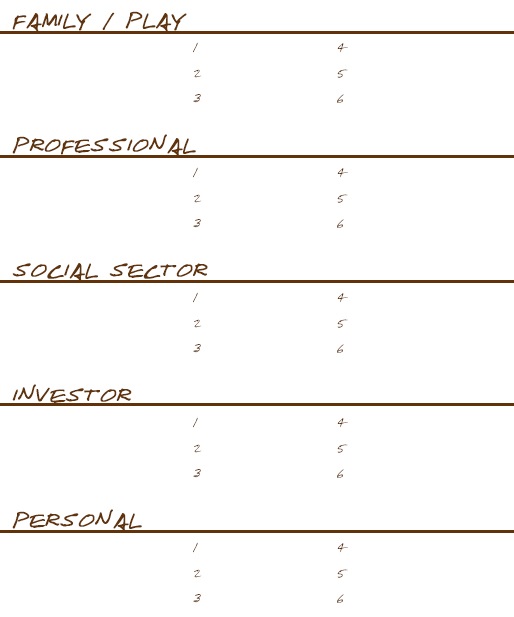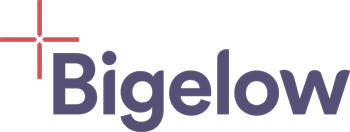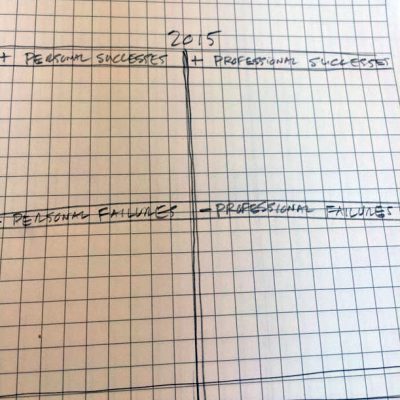If you are going to invest in your future best self, where do you want to make the investment for the optimal outcome? Are exceptional results a matter of chance, or do we cause them? Working through a personal performance review and a go-forward energy allocation plan seems like hard work. Why bother—unless you’re interested in peak performance or optimum life experience? And if you do bother, how do you create an effective one anyway?
Many of you have asked about the practice I engage in during the course of a year and the requests from my close friends / Entrepreneur Owner-Managers who ask, “specifically how do you do that?” have reached the point where I feel like a little post to share what my actions are could be helpful. Since I first shared these thoughts a few years ago, I have significantly updated my thinking (and my practice). Now I increasingly emphasize relationships, and my thinking has gone long long-term. You did not ask me what you should do, but what I do, so I will share the methodology that I use to strive for goals—not to prescribe, but just to describe.
I am endlessly interested in optimal performance and experience. In anyone. Building our lives around our superior skills and abilities, not what we are weak on or have to work on. Every year since 1980 I put myself in the petri dish and invest several days assessing my own personal performance for the year ending, and think deeply about my direction for the next several years. I convert those thoughts then into a written self-appraisal of my personal performance and a simple go-forward personal annual plan resulting in intentionally allocating my energy.
Look, no one can predict the future; it is simply not knowable. Chance (good and bad) happens. And success or failure is very often more a matter of chance than we credit. So I am no way implying there is a top down solution—a top down prescription by which we all should live. Whether you do a personal annual plan or not has no effect on the external environment. But a personal annual plan can give a navigational chart to a general destination—a destination that may ultimately be shaped by events that are not knowable in advance. It will allow you to study that navigational chart in the cool of the night, allowing your rational and logical self to overcome some of the strong emotions you feel when things don’t go quite as expected. You cannot predict, but you can become more resilient to surprises, discontinuities, and bumps by having that nav chart with a destination and milestones along the way to measure progress.
Since the principal challenges for successful people are overwhelmingly behavioral, my approach is to very purposefully choose where to invest my positive energy (what behaviors to invest positive energy into). Doing this repeatedly, where I invest energy for optimal performance goes from being a discipline (hard) to a habit (easy). The context is that my career or business doesn’t own me—I own my career and my business. And since the environment we operate in is constantly changing, the overall outline for assessing your performance and the areas that matter most to you for energy investment in the future definitely is not rigid, nor is it meant to be converted into a daily calendar. But it will give you a view over time for evaluating if where you are investing energy now is taking you to your Promised Land. More importantly, it allows you to subtract: to intentionally and systematically discard unproductive complexity. For me that’s less time shackled to a table with a glowing screen on it, and more time in the field with my friends / clients where, when connecting the dots, the big aha flashes of insight come from that which allow me to bring value to them. Good things happen when I purposefully replace screen-time with face-time.
Finally, I have found that a thoughtful personal plan provides you with motivation. Over time, it gives you prolonged practice, and (if you are honest with yourself) objective feedback. There are insights in our lives that only practice or experience will reveal and that no spreadsheet or analysis will ever capture in full. In a phrase—positive learning and growing. It allows us a simple way to authentically keep score and raise our own performance bar. The best outcome from an annual personal performance review and personal annual plan? A new, satisfying mind-set.
Many of you have heard me describe some of the outwardly “successful” but inwardly desperately unhappy Entrepreneur Owner-Managers I have met who set idealistic goals and then get discouraged when they don’t seem to get closer to them. Every year they become more and more frustrated that they are not achieving their ideal vision. The method I advocate here—specifically, deeply thinking about your performance, setting goals by looking ahead, but then most importantly looking over your shoulder and assessing your performance by looking at where you came from is one of the most rewarding parts of the exercise. Setting goals looking to the future and measuring improvement by looking at the past (progress from where you started) results in gratitude for advancements made in the past, and a basis for steady optimism about the future.
The year-end assessment and annual plan is not meant to be shared in detail with anyone, so I have the habit of being brutally honest and wholly self-critical in it, knowing that it isn’t for publication.
So here are my actual paper and pencil three simple steps: Year End Performance Assessment, Brain Storming New Year Goals, and Prioritized Domain-Specific Goals.
1. Year End Performance Assessment. I sit down toward the end of the year with paper and pencil. I am sure that my methods can be easily converted to spreadsheet for those who care to—I have deliberately chosen to use poster-sized paper and pencil (never pen) as I find that the very act of drawing graphite curves and doodling arrows on a blank sheet inspires my thoughts and open-mindedness. I divide my paper into four quadrants. Upper left: Professional Successes. Lower Left: Professional Disappointments. Upper Right: Personal Successes. Lower Right: Personal Disappointments. And I begin to think about the year in those two domains of my life Professional and Personal and think through and write down very honestly what I view as successes and disappointments (or failures). Often the successes are not solo, but involve others. What went really well this year? What are some things I am really (privately) proud of? What was I disappointed in, or what really stinks this year? Did I have some dramatic failures? Where did my performance not live up to my expectation either because of commission, omission, or even just chance?
Funny thing about the willingness to constructively confront and honestly think about failures. Often, thinking deeply and sometimes painfully about failures (missed expectations, face plants, or just plain didn’t put in the energy to achieve) finally ends up with an arrow drawn to the success quadrant as a way of learning where to go from here (“whew, this was bad” or “not going to do this again” or “didn’t seem that I really wanted to achieve this goal, did it”). Through this process I take risks, and in effect am performing life experiments as I am going along, so I have learned to expect there will be certain hard failures. And those failures if examined and rapidly acted on, lead to post-traumatic growth, shape one’s go-forward behavior, and are absolutely the best professor I have ever had.
Successes inform me too. Sometimes the successes are related to the plan I made the year before and I can infer cause / effect from the energy I put into them; other times they are mostly chance. Sometimes I reach goals I have been striving for, for years. Other times my assessment makes me reflect on the worthiness (or not!) of some of my goals at all. One of the conclusions you might reach, as I have after doing this for over twenty five years, is that Chance Happens.
2. Brain Storming New Year Goals. Once I have made a good start on the Personal Assessment I usually put it down for a while and work on the next step. I stare at the ceiling for a bit and begin scribbling an inventory—a free flowing mental dump of some of my goals for the next year that have been occurring to me (and I have been scribbling on scraps of paper) throughout the year. Again, I take a blank sheet of poster-sized paper and do a mental dump, without categorization or prioritization of goals for the New Year I have been thinking about. I am willing at this point to be daring, even silly about goals, as at this point I merely want to capture the ideas. I will decide in a later draft what to include in my energy allocation. Since I have an abundance of physical and mental energy, many of these brainstormed goals are out of the box—some of them way out of the box. Many involve other people. Which raises a question. Why not do this kind of planning with your spouse or life partner? I suppose you could have a merged plan in the family / play domain (as you think about travel for example), but since I am an individual with free will and I am determined to take personal responsibility for where I allocate my energy (and my resulting behavior), then for me, the correct view is necessarily individual.
3. Prioritized Domain-Specific Goals. This step is a longer, more organizing stage in the planning process. I have found it most useful for me to think about prioritizing my annual goals by domains in my life. The domains I currently use are:
“Family/Play” (thinking about myself as a husband, son, brother, family member); “Professional” (working in Bigelow’s practice and working on Bigelow’s practice); “Social Sector” (my work as a volunteer in the private not-for-profit organizations I am committed to); “Investor” (mostly related to continually simplifying my “barbell” investment strategy for my family balance sheet); and “Personal” (often related to psychological, physical fitness, learning, and other goals that I might have). For me, building relationships are the common thread through my thinking here. Sure they’re messy, complex, and need energy. But they’re the real thing. Individuals are real, while organizations only exist in the abstract, right?
So once again I turn to a blank poster-sized sheet and now list my five domains down the left vertical margin, and then each of the goals that go with that domain from the brainstorming. Over the years I have had to work hard to list 1,2,3,4,5,6,7 (and then I always discard 7, otherwise my lists of goals gets too long to implement). I am certain that other domains, other domain headings, and modified structure or descriptions will work for you. It seems to me that it is critical to have domains regardless of how you label them, so that you have digestible “data chunking” for intelligent goal setting.

Are you ever “done?” Do the best EOMs ever quit this kind of thinking? Doubt it. What it may take to be completely fulfilled is to understand this: the natural human condition is to tirelessly strive—and never really arrive at a “place” called fulfillment. Striving is inherited from thousands of years of biological selection and is literally imprinted in our DNA. It’s what we are built to do. If we can understand that striving will result in learning and growing and never ending positive change, then with that wisdom we are in a completely fulfilled place, aren’t we?
I admit this is only a semi-directed, groping, bumbling process of trial and error with but a vague (though gradually clearer) notion of the mechanisms at work. It is applied scar tissue. And while I think we can learn much from thinking about cause and effect, I am deeply doubtful about how our popular culture casually attributes cause and effect—it is always ex post facto, and underemphasizes the role of chance (chance being defined here as not causally connected). I notice in my work as and with EOMs that we frequently do this when we look at our own past successes.
Nonetheless, I hope that those of you who are “doers,” have your skin in the game and your wits at risk, will share your thoughts with me on what works for you and what doesn’t, so that together we might learn even more from your creativity and scar tissue. Have some fun with this. Why continue to get bogged down with commitments or obligations that do not resonate with your superior ability or for which you have no passion? I challenge you to discard your usual bullshit comfort zone head down grind it out mentality, and intentionally allocate your positive energy to unlock the peak performance—and experiences—that live within you.
References and Further Reading:
Ridley, Matt. The Evolution of Everything: How New Ideas Emerge. New York: HarperCollins, 2015. Print.
Schopenhauer, Arthur (2000) [1851]. Transcendent Speculation in the Apparent Deliberateness in the Fate of the Individual in Parerga and Paralipomena. E. F. J. Payne translation. Oxford: Clarendon Press.
© 2024 Bigelow LLC. All rights reserved.

